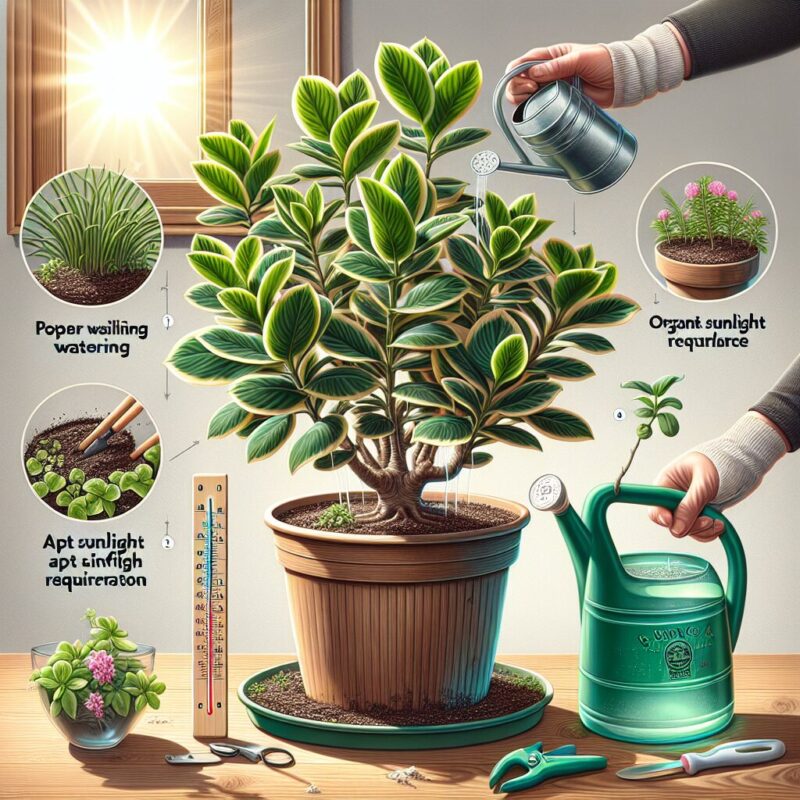The Calandiva plant, also known as Kalanchoe blossfeldiana, is a popular choice for indoor gardeners due to its vibrant and long-lasting blooms. Native to Madagascar, this succulent plant belongs to the Crassulaceae family and is characterized by its thick, fleshy leaves and clusters of small, colorful flowers. One unique fact about the Calandiva plant is its ability to thrive in various lighting conditions, making it an ideal choice for both experienced and novice plant enthusiasts.
When it comes to caring for a Calandiva plant, there are several key factors to consider. First and foremost, providing the right amount of light is crucial for its overall health and bloom production. While these plants can tolerate low light conditions, they thrive in bright, indirect sunlight. Additionally, watering is another essential aspect of Calandiva plant care. Overwatering can lead to root rot, while underwatering can result in wilted leaves and diminished flower production. Finding the right balance is key. Now, let’s delve into the key takeaways to help you successfully care for your Calandiva plant and enjoy its beauty for years to come.
Key Takeaways
1. Provide the Calandiva plant with bright, indirect sunlight and keep it away from direct sunlight to avoid leaf burn.
2. Water the plant thoroughly when the top inch of soil is dry, allowing excess water to drain out, but avoid overwatering as it can lead to root rot.
3. Maintain a consistent temperature between 60-75°F (15-24°C) and avoid exposing the plant to drastic temperature changes or drafts.
4. Fertilize the Calandiva plant with a balanced, water-soluble fertilizer every 2-4 weeks during the growing season to promote healthy growth.
5. Keep an eye out for common pests such as aphids, mealybugs, or spider mites, and promptly treat with organic insecticides or by wiping leaves with a damp cloth to prevent infestation.
How to Properly Take Care of a Calandiva Plant
Light Requirements
Calandiva plants thrive in bright, indirect light. They should be placed near a window with filtered sunlight. Avoid exposing the plant to direct sunlight, as it can cause leaf burn and damage.
Temperature and Humidity
Calandiva plants prefer temperatures between 60-75°F (15-24°C). Avoid extreme temperature fluctuations and keep the plant away from drafts. They also enjoy a moderate level of humidity, so mist the plant occasionally to provide adequate moisture.
Watering
It is important not to overwater a Calandiva plant. Allow the top inch of soil to dry out before watering. Use your finger to test the moisture level – if it feels dry, it’s time to water. Ensure the soil is well-drained to prevent waterlogging.
Soil and Fertilizer
Calandiva plants prefer well-draining, slightly acidic soil. A mixture of peat moss, perlite, and potting soil works well. Fertilize the plant every 2-3 months with a balanced, water-soluble fertilizer, following the instructions on the packaging.
Pruning and Deadheading
To encourage bushier growth, it is recommended to prune a Calandiva plant regularly. Remove any dead or yellowing leaves, as well as spent flowers. This will help redirect energy for new growth and blooming.
Pests and Diseases
Calandiva plants are generally resistant to pests and diseases. However, keep an eye out for common houseplant pests like aphids, mealybugs, and spider mites. If detected, treat the infestation promptly with insecticidal soap or neem oil.
Propagation
Propagation of Calandiva plants can be done through stem cuttings. Take a healthy stem cutting, remove the lower leaves, and dip the cut end in rooting hormone. Plant the cutting in a well-draining potting mix and keep it slightly moist until roots develop.
Common Issues
Calandiva plants may face some common issues, such as yellowing leaves, wilting, or lack of blooming. These can be attributed to overwatering, inadequate light, or improper temperature. Adjust the care conditions accordingly to address these problems.
Final Tips: How to Take Care of a Calandiva Plant
- Ensure the Calandiva plant receives bright, indirect light.
- Keep the temperature between 60-75°F (15-24°C) with consistent humidity levels.
- Water the plant when the top inch of soil is dry and provide good drainage.
- Use well-draining, slightly acidic soil and fertilize every 2-3 months.
- Regularly prune and deadhead to promote bushy growth.
- Watch out for pests and treat them promptly if detected.
- Propagate through stem cuttings in proper rooting conditions.
- Address common issues like yellowing leaves or lack of blooming by adjusting care conditions.
Frequently Asked Questions:
1. What is a Calandiva plant?
A Calandiva plant is a type of succulent that produces colorful and long-lasting flowers. It is known for its compact size and ability to thrive both indoors and outdoors.
2. How often should I water my Calandiva plant?
It is important to water your Calandiva plant thoroughly whenever the top inch of the soil feels dry. However, be careful not to overwater it as it can lead to root rot.
3. Can I keep my Calandiva plant in direct sunlight?
While Calandiva plants can tolerate direct sunlight, it is best to place them in areas with bright, indirect light. Too much direct sunlight can scorch their leaves.
4. Do I need to fertilize my Calandiva plant?
Yes, you should fertilize your Calandiva plant every two to four weeks during the growing season (spring and summer). Use a balanced, water-soluble fertilizer and follow the package instructions for proper dilution.
5. How do I promote blooming in my Calandiva plant?
To encourage blooming, make sure to provide your Calandiva plant with at least 14 hours of darkness each day. This can be achieved by moving it to a dark location or covering it with a light-blocking material in the evenings.
6. Can I propagate my Calandiva plant?
Yes, you can propagate Calandiva plants through stem cuttings. Simply take a cutting from a healthy plant, let it callus for a few days, and then plant it in well-draining soil. Keep the soil slightly moist until new roots develop.
7. Should I prune my Calandiva plant?
Pruning is not necessary for Calandiva plants, but you can remove any dead or yellowing leaves to maintain their appearance and promote airflow within the plant.
8. Can I keep my Calandiva plant outdoors during winter?
No, Calandiva plants are sensitive to frost and cold temperatures. It is best to bring them indoors or provide them with protection if the temperature drops below 50°F (10°C).
9. How long do Calandiva flowers last?
Calandiva flowers typically last for several weeks, but their blooming period can vary depending on the growing conditions and care provided.
10. Why are the leaves of my Calandiva plant turning yellow?
Yellow leaves on a Calandiva plant can be a sign of overwatering, underwatering, or insufficient light. Assess the watering routine and ensure the plant is receiving adequate light to address the issue.
Final Thoughts:
The Calandiva plant is a delightful addition to any indoor or outdoor garden. With proper care and attention, this succulent can reward you with beautiful, long-lasting flowers. Remember to strike the right balance in watering, provide enough light, and fertilize it correctly to ensure its optimal growth and blooming. By following the guidelines outlined in this article, you can enjoy the vibrant colors and charm of your Calandiva plant for an extended period.
Taking care of a Calandiva plant may require some time and effort, but the results are well worth it. The exquisite flowers and low-maintenance nature of this succulent make it a perfect choice for both novice and experienced gardeners. So, embrace the joys of nurturing a Calandiva plant and witness its beauty bloom throughout the seasons. Happy gardening!

